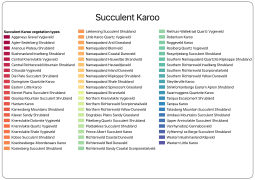| Succulent Karoo | |
|---|---|
 Goegap Nature Reserve, South Africa | |
 Location of the Succulent Karoo ecoregion | |
| Ecology | |
| Realm | Afrotropical |
| Biome | deserts and xeric shrublands |
| Borders | |
| Geography | |
| Area | 102,700 km2 (39,700 sq mi) |
| Countries | |
| Conservation | |
| Conservation status | Relatively stable[1] |
| Protected | 2352 km2 (2%)[1] |

The Succulent Karoo is an ecoregion defined by the World Wide Fund for Nature to include regions of desert in South Africa and Namibia,[2] and a biodiversity hotspot. The geographic area chosen by the WWF for what they call 'Succulent Karoo' does not correspond to the actual Karoo.
YouTube Encyclopedic
-
1/1Views:2 812
-
Plant Select South African Ice Plants with Panayoti Kelaidis, Denver
Transcription
Geography
The Succulent Karoo stretches along the coastal strip of southwestern Namibia and South Africa's Northern Cape Province, where the cold Benguela Current offshore creates frequent fogs. The ecoregion extends inland into the uplands of South Africa's Western Cape Province. It is bounded on the south by the Mediterranean climate fynbos, on the east by the Nama Karoo, which has more extreme temperatures and variable rainfall, and on the north by the Namib Desert.
-
Succulent Karoo vegetation types
-
Flora
The Succulent Karoo is notable for the world's richest flora of succulent plants, and harbours about one-third of the world’s approximately 10,000 succulent species. 40% of its succulent plants are endemic.[3] The region is extraordinarily rich in geophytes, harbouring approximately 630 species.
Fauna
The ecoregion is a centre of diversity and endemism for reptiles and many invertebrates. Of the ecoregion’s 50 scorpion species, 22 are endemic. Monkey beetles, largely endemic to southern Africa, are concentrated in the Succulent Karoo and are important pollinators of the flora. So, too, are the Hymenoptera and masarine wasps, and colletid, fideliid, and melittid bees.[1]
Approximately 15 amphibians are found in this ecoregion, including three endemics; among the region’s 115 reptile species, 48 are endemic and 15 are strict endemics.[clarification needed] The Sperrgebiet region is a hotspot for an unusual tortoise, the Nama padloper. Endemism is present, but less pronounced, among the Succulent Karoo’s bird and mammal populations.[1]
Conservation
The ecoregion has been designated a biodiversity hotspot by Conservation International.

See also
References
- ^ a b c d "Succulent Karoo". Terrestrial Ecoregions. World Wildlife Fund.
- ^ Centre, UNESCO World Heritage. "Succulent Karoo Protected Areas - UNESCO World Heritage Centre". whc.unesco.org. Retrieved 2017-07-13.
- ^ "Succulent Karoo - The Environmental Literacy Council". The Environmental Literacy Council. Retrieved 2017-07-13.
External links
- "Succulent Karoo". Terrestrial Ecoregions. World Wildlife Fund.
- Succulent Karoo biodiversity hotspot (Conservation International)
- Succulent Karoo (PlantZAfrica.com)
| |||||||||||||||||||||||||||
| |||||||||||||||||||||||||||
| |||||||||||||||||||||||||||
| |||||||||||||||||||||||||||
| |||||||||||||||||||||||||||
| |||||||||||||||||||||||||||
| |||||||||||||||||||||||||||
| Central | |
|---|---|
| East | |
| North | |
| South | |
| West | |
| Macro-regions |
|


